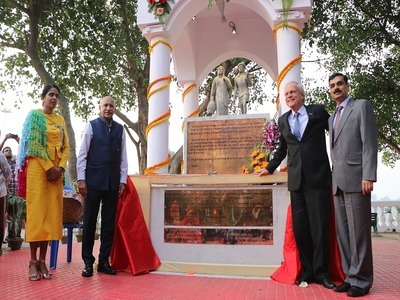Kolkata :
On February 26, 1873, sailship Lalla Rookh set off from what is now known as Suriname Ghat with 410 passengers on board. Nearly all of them were from places that are now in Uttar Pradesh and Bihar. The men and women had been recruited as ‘coolies’ or indentured labourers by the Dutch who owned sugarcane plantations in Suriname. The ship docked at Paramaribo on June 5 with 279 men, 70 women and 50 children. Eleven did not survive the voyage. In the years that followed, 63 more ships left Kolkata port for Suriname.
Nearly 145 years later, a descendant of one of the 34,304 Indian labourers who were transported to a distant land in the northern tip of South America returned to the very ghat from where her ancestor had set sail and survived the arduous journey. It was a poignant moment for Aashna Kanhai, the Surinamese ambassador to India, as she stood at ‘Mai Baap’ Memorial on Suriname Ghat and looked at the shimmering waters of the Hooghly.
“Today, there are 170,000 people of Indian origin in Suriname (the total population is 558,368). There are also 200,000 of them in Holland who decided to leave Suriname when the country became independent 42 years ago,” said Kanhai as she folded her palms in a namaskaar in front of the Mai Baap Memorial.

The occasion that had brought Kanhai to Kolkata was Suriname Day. “My ancestors must have stood here for the last time before leaving India forever. The men carried two dhotis and two kurtas each. The women carried two saris each. Apart from this, some carried religious books like the Ramayana, Mahabharata or Quran,” Kanhai said, her voice choked with emotion.
Aashna Kanhai, the Surinamese ambassador to India, celebrated Suriname Day on the banks of Hooghly on Saturday, accompanied by minister of state for external affairs MJ Akbar, who unveiled a plaque at the Mai Baap Memorial on Suriname Ghat.
The memorial comprises a sculpture of a man and a woman, each carrying a potli, to commemorate the landing of Indian labourers at Paramaribo. The original sculpture is in Paramaribo and its replica was inaugurated in Kolkata in 2015.
Her great grandmother’s father was among the indentured labourers who landed in Suriname. During an earlier visit to Kolkata, she had heard the name Bhawanipore and it rang a bell. “I recalled that my ancestors were kept at the Bhawanipore Depot before they boarded the ship,” Kanhai added.
Initially, the transport and living conditions of Indian labourers in Suriname was worse than it had been prior to the abolition of the Dutch slave trade. Many died during the journey.
But why did the Dutch planters require Indian labourers? “In 1863, slavery was abolished by the Dutch and they entered into an agreement with the East India Company to recruit labourers from India to work in the sugarcane plantations in Suriname. Men, known as Arkatias were sent out to recruit people from Uttar Pradesh and Bihar. They entered into a five-year contract and came to be known as the Contrakees or Agreemanees. They were to receive 25-pence a week for their labour but payment was often delayed. Of the 34,000-odd Indians who reached Suriname, 65% stayed back. Indentured labour was finally abolished 100 years ago in 1917,” the Surinamese ambassador said.
During the event, videos of renditions by Surinamese singer Raj Mohan were screened. In a Bhojpuri song, the singer brought out the feelings of a ‘coolie’ after he realized that he had been cheated. The second song by Mohan was Tagore’s Ami Chini Go Chini Tomarey, Ogo Bideshini. Kanhai, who speaks fluent Bhojpuri, said that the only Bengali she knows is the Rabindrasangeet which is extremely popular in Suriname.”That one stanza of the Bhojpuri song says it all. It reveals how the labourers from India had gone to Suriname with plans to return after five years with small fortunes. Once there, they realized that they were cheated. They were taken there as replacement slaves. Such was colonialism. They just played with words to make things sound better. The Hooghly wasn’t a river of hope. It was a river of no return. The peasants left their lands in the first place because of the huge taxation imposed by the colonial government in India. They had no surplus during lean seasons. Through such programmes, we celebrate the resilience of human spirit,” Akbar said.
While Dutch ambassador Alphonsus Stoelinga recounted how his country shared a piece of history with India and Suriname, Kolkata Port Trust chairman Vinit Kumar said there are plans to improve the surroundings of the memorial. “The first labour ship to leave Kolkata for the Mauritius was in 1834. Later, ships left for several countries. We have plans to organize heritage tours to the Suriname Ghat and create a larger indenture memorial. We shall also upgrade the surroundings,” Kumar said.
source: http://www.timesofindia.indiatimes.com / The Times of India / News> City News> Kolkata News / by Jayanta Gupta / TNN / November 26th, 2017
Dear Sir / Madam
Thank you for sharing your experiences.
I am from Mauritius and willing also to know more about my ancestors. I am here for this occasion. Now in Kolkata.
Sincerely yours
Swasti Bolay